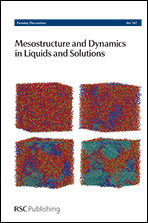A mesoscopic model for the rheology of soft amorphous solids, with application to microchannel flows
Abstract
We have studied a mesoscopic model for the flow of amorphous solids. The model is based on key features identified at the microscopic level, namely periods of elastic deformation interspersed with localised rearrangements of particles that induce long-range elastic deformations. These long-range deformations are derived following a continuum mechanics approach, in the presence of solid boundaries, and are included in full in the model. Indeed, they mediate spatial cooperativity in the flow, whereby a localised rearrangement may lead a distant region to yield. In particular, we have simulated a channel flow and found manifestations of spatial cooperativity that are consistent with published experimental observations for concentrated emulsions in microchannels. Two categories of effects are distinguished. On the one hand, the coupling of regions subject to different shear rates, for instance, leads to finite shear rate fluctuations in the seemingly unsheared “plug” in the centre of the channel. On the other hand, there is convincing experimental evidence of a specific rheology near rough walls. We discuss the diverse possible physical origins for this effect, and we suggest that it may be associated with the bumps of particles into surface asperities as they slide along the wall.
- This article is part of the themed collection: Mesostructure and Dynamics in Liquids and Solutions

 Please wait while we load your content...
Please wait while we load your content...